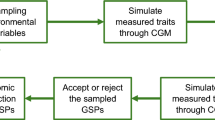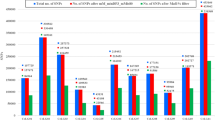Abstract
Cowpea is a legume widely grown in Africa, North, Central and South America, and Asia. The cowpea plant growth habits consist of erect, semi-prostrate, and prostrate types. Developing a cultivar while considering plant growth habit is essential within a breeding program since the need for a particular growth habit is region-specific, and significantly depends on the end user preference. Some cowpea growers might prefer erect types over semi-prostrate and prostrate types, while others would chose prostrate types, which provide more leaves for feed supplies to livestock. However, very little is known regarding the genetics of plant growth habit in cowpea to assist plant breeders in developing suitable cowpea cultivars having the desired growth habit plus the other required features. Therefore, the objectives of this study were to conduct an association mapping for cowpea growth habit, and to identify SNP markers associated with this trait. A total of 487 cowpea genotypes were evaluated for growth habit and a total of 1031 SNPs postulated from genotyping-by-sequencing to conduct association analysis study for cowpea growth habit. Our results showed that: (1) significant differences in cowpea growth habit were identified between countries, (2) the cowpea erect-type was prevalent, and (3) ten SNP markers, C35060651_729, C35061339_799, C35062457_1855, C35072764_1384, C35080248_2355, Scaffold2771_4351, Scaffold29522_3213, Scaffold35913_2678, Scaffold53560_188, and Scaffold58098_4297, were significantly associated with cowpea growth habit. These results could be used for enhancing marker-assisted selection (MAS) in breeding programs aimed at developing cowpea cultivars having a particular growth habit.





Similar content being viewed by others
References
Ai Y, Zhang Q, Pan C, Zhang H, Ma S, He Y, Bao M (2015) A study of heterosis, combining ability and heritability between two male sterile lines and ten inbred lines of Tagetes patula. Euphytica 203:349–366
Ali L, Azam S, Rubio J, Kudapa H, Madrid E, Varshney RK, Castro P, Chen W, Gil J, Millan T (2015) Detection of a new QTL/gene for growth habit in chickpea CaLG1 using wide and narrow crosses. Euphytica 204:473–485
Aryamanesh N, Nelson MN, Yan G, Clarke HJ, Siddique KHM (2010) Mapping a major gene for growth habit and QTLs for ascochyta blight resistance and flowering time in a population between chickpea and Cicer reticulatum. Euphytica 173:307–319
Ba FS, Pasquet RS, Gepts P (2004) Genetic diversity in cowpea [Vigna unguiculata (L.) Walp.] as revealed by RAPD markers. Genet Resour Crop Evol 51:539–550
Badiane F, Diouf M, Diouf D (2014) Cowpea. In: Singh M, Bish IS, Dutta M (eds) Broadening the genetic base of grain legumes. Springer, New Delhi, pp 95–114
Bastien M, Sonah H, Belzile F (2014) Genome wide association mapping of resistance in soybean with a genotyping-by-sequencing approach. Plant Genome 7:1–13
Bhattarai G, Mehlenbacher SA (2017) In silico development and characterization of tri-nucleotide simple sequence repeat markers in hazelnut (Corylus avellana L.). PLoS ONE 12:e0178061
Bradbury PJ, Zhang Z, Kroon DE, Casstevens TM, Ramdoss Y, Buckler ES (2007) TASSEL: software for association mapping of complex traits in diverse samples. Bioinformatics 23:2633–2635
Carvalho M, Lino-Neto T, Rosa E, Carnide V (2017) Cowpea: a legume crop for a challenging environment. J Sci Food Agric. https://doi.org/10.1002/jsfa.8250
Checa OE, Blair MW (2008) Mapping QTL for climbing ability and component traits in common bean (Phaseolus vulgaris L.). Mol Breed 22:201–215
Davis VM, Mellendorf NE, Villamil MB, Nafziger ED (2015) Initial plant size affects response to thinning in soybean. Agron J 107:158–166
Earl DA, VonHoldt BM (2011) STRUCTURE HARVESTER: a website and program for visualizing STRUCTURE output and implementing the Evanno method. Conserv Genet Resour 4:359–361
Elshire RJ, Glaubitz JC, Sun Q, Poland JA, Kawamoto K, Buckler ES, Mitchell SE (2011) A robust, simple genotyping-by-sequencing (GBS) approach for high diversity species. PLoS ONE 6:e19379
Evanno G, Regnaut S, Goudet J (2005) Detecting the number of clusters of individuals using the software STRUCTURE: a simulation study. Mol Ecol 14:2611–2620
Fang J, Chao CCT, Roberts PA, Ehlers JD (2006) Genetic diversity of cowpea [Vigna unguiculata (L.) Walp.] in four West African and USA breeding programs as determined by AFLP analysis. Genet Resour Crop Evol 54:1197–1209
Fang WP, Meinhardt LW, Tan HW, Zhou L, Mischke S, Zhang D (2014) Varietal identification of tea (Camellia sinensis) using nanofluidic array of single nucleotide polymorphism (SNP) markers. Hortic Res 1:14035
Faris D (1964) The chromosome number of Vigna sinensis (L.) Savi. Can J Genet Cytol 6:255–258
Filho CM, Gomes R, Filho FF (2014) Inheritance of traits related to plant architecture in cowpea. Cienc Rural 44:599–604 (In Spanish)
Fonceka D, Tossim HA, Rivallan R, Vignes H, Lacut E, de Bellis F, Faye I, Ndoye O, Leal-Bertioli SCM, Valls JFM, Bertioli DJ, Glaszmann JC, Courtois B, Rami JF (2012) Construction of chromosome segment substitution lines in peanut Arachis hypogaea (L.) using a wild synthetic and QTL mapping for plant morphology. PLoS ONE 7:e48642
Fratini R, Durán Y, García P, Pérez DVM (2007) Identification of quantitative trait loci (QTL) for plant structure, growth habit and yield in lentil. Span J Agric Res 5:348–356
Kisha TJ, Sneller CH, Diers BW (1997) Relationship between genetic distance among parents and genetic variance in populations of soybean. Crop Sci 37:1317–1325
Kumar S, Stecher G, Tamura K ( 2016) MEGA7: molecular evolutionary genetics analysis version 7.0 for bigger datasets. Mol Biol Evol 33:1870–1874
Lander ES, Botstein D (1989) Mapping Mendelian factors underlying quantitative traits using rflp linkage maps. Genetics 121:185–199
Li R, Yu C, Li Y, Lam TW, Yiu SM, Kristiansen K, Wang J (2009) SOAP2: an improved ultrafast tool for short read alignment. Bioinformatics 25:1966–1967
Liu B, Fujita T, Yan ZH, Sakamoto S, Xu D, Abe J (2007) QTL mapping of domestication-related traits in soybean (Glycine max). Ann Bot 100:1027–1038
Liu X, Huang M, Fan B, Buckler ES, Zhang Z, Bradbury P (2016) Iterative usage of fixed and random effect models for powerful and efficient genome-wide association studies. PLoS Genet 12:e1005767
Mian MAR, Ashley DA, Vencill Boerma HR (1998) QTLs conditioning early growth in a soybean population segregating for growth habit. Theor Appl Genet 97:1210–1216
Pritchard JK, Stephens M, Donnelly P (2000) Inference of population structure using multilocus genotype data. Genetics 155:945–959
Qin J, Shi A, Xiong H, Mou B, Motes D, Lu W, Miller JC, Scheuring DC, Nzaramba MN, Weng Y, Yang W (2016) Population structure analysis and association mapping of seed antioxidant content in USDA cowpea (Vigna unguiculata L. Walp.) core collection using SNPs. Can J Plant Sci 96:1026–1036
Qin J, Shi A, Mou B, Bhattarai G, Yang W, Weng Y, Motes D (2017) Association mapping of aphid resistance in USDA cowpea (Vigna unguiculata L. Walp.) core collection using SNPs. Euphytica 213:36
Quick G (1970) Combine harvesters for soybean research. MsC Thesis, Iowa State University, Ames
Ramasamy RK, Ramasamy S, Bindroo BB, Naik VG (2014) STRUCTURE PLOT: a program for drawing elegant STRUCTURE bar plots in user friendly interface. SpringerPlus 3:431
Ravelombola W, Qin J, Shi A, Lu W, Weng Y, Xiong H, Yang W, Bhattarai G, Mahamane S, Payne WA, Miller JC, Scheuring D (2017) Association mapping revealed SNP markers for adaptation to low phosphorus conditions and rock phosphate response in USDA cowpea (Vigna unguiculata (L.) Walp.) germplasm. Euphytica 213:183
Richard A (1851) Tentamen florae abyssinicae seu enumeratio plantarum hucusque in plerisque Abyssiniae provinciis detectarum et praecipue a beatis doctoribus Richard Quatrtin Dillon et Antonio Petit (Annis 1838–1843) lectarum. Arthus Bertrand, Paris, pp 50–51
Shi A, Buckley B, Mou B, Motes D, Morris JB, Ma J, Xiong H, Qin J, Yang W, Chitwood J, Weng Y, Lu W (2016) Association analysis of cowpea bacterial blight resistance in USDA cowpea germplasm. Euphytica 208:143–155
Silva PB, Silva PL (2008) Planting times of cowpea intercropped with corn in the weed control’. Rev Caatinga 21:113–119
Soltani A, Bello M, Mndolwa E, Schroder S, Moghaddam SM, Osorno JM, Miklas PN, McClean PE (2016) Targeted analysis of dry bean growth habit: interrelationship among architectural, phenological, and yield components. Crop Sci 56:3005–3015
Timko MP, Rushton PJ, Laudeman TW, Bokowiec MT, Chipumuro E, Cheung F, Town CD, Chen X, Henckel K, Goesmann A, Meyer F, Wipf D, Requena N, Hildebrandt U, Hampp R, Nehls U, Krajinski F, Franken P, Puhler A, Debelle F, Cook D, Retzel E, Roe B, Town C, Tabata S, Peer YVD, Young N (2008) ‘Sequencing and analysis of the gene-rich space of cowpea. BMC Genom 9:103
Uchino H, Uozumi S, Touno E, Kawamoto H, Deguchi S (2016) Soybean growth traits suitable for forage production in an Italian ryegrass living mulch system. Field Crops Res 193:143–153
Varshney RK, Nayak SN, May GD, Jackson SA (2009) Next-generation sequencing technologies and their implications for crop genetics and breeding. Trends Biotechnol 27:522–530
Wang G, McGiffen M, Lindquist J, Ehlehrs J, Sartorato I (2007) Simulation study of the competitive ability of erect, semi-erect and prostrate cowpea (Vigna unguiculata) genotypes. Weed Res 47:129–139
Xiong H, Shi A, Mou B, Qin J, Motes D, Lu W, Ma J, Weng Y, Yang W, Wu D (2016) Genetic diversity and population structure of cowpea (Vigna unguiculata L. Walp). PLoS ONE 11:e0160941
Acknowledgements
Cowpea germplasm accessions were provide by the USDA, ARS, and PGRCU at GRIFFIN, GA. The cowpea_Genome_0.03.fa (6750 scaffolds or contigs) (http://harvest-blast.org/) was kindly provided by Dr. Timothy J. Close at the University of California Riverside, CA, USA. This work is supported, in part, by the USDA National Institute of Food and Agriculture Hatch Project Accession Number 1002423.
Author information
Authors and Affiliations
Corresponding author
Ethics declarations
Conflict of interest
The authors declare that they have no conflict of interest.
Ethical approval
This article does not contain any studies with human participants or animals performed by any of the authors.
Electronic supplementary material
Below is the link to the electronic supplementary material.
Rights and permissions
About this article
Cite this article
Ravelombola, W., Qin, J., Shi, A. et al. A SNP-based association analysis for plant growth habit in worldwide cowpea (Vigna unguiculata (L.) Walp) Germplasm. Euphytica 213, 284 (2017). https://doi.org/10.1007/s10681-017-2077-z
Received:
Accepted:
Published:
DOI: https://doi.org/10.1007/s10681-017-2077-z




